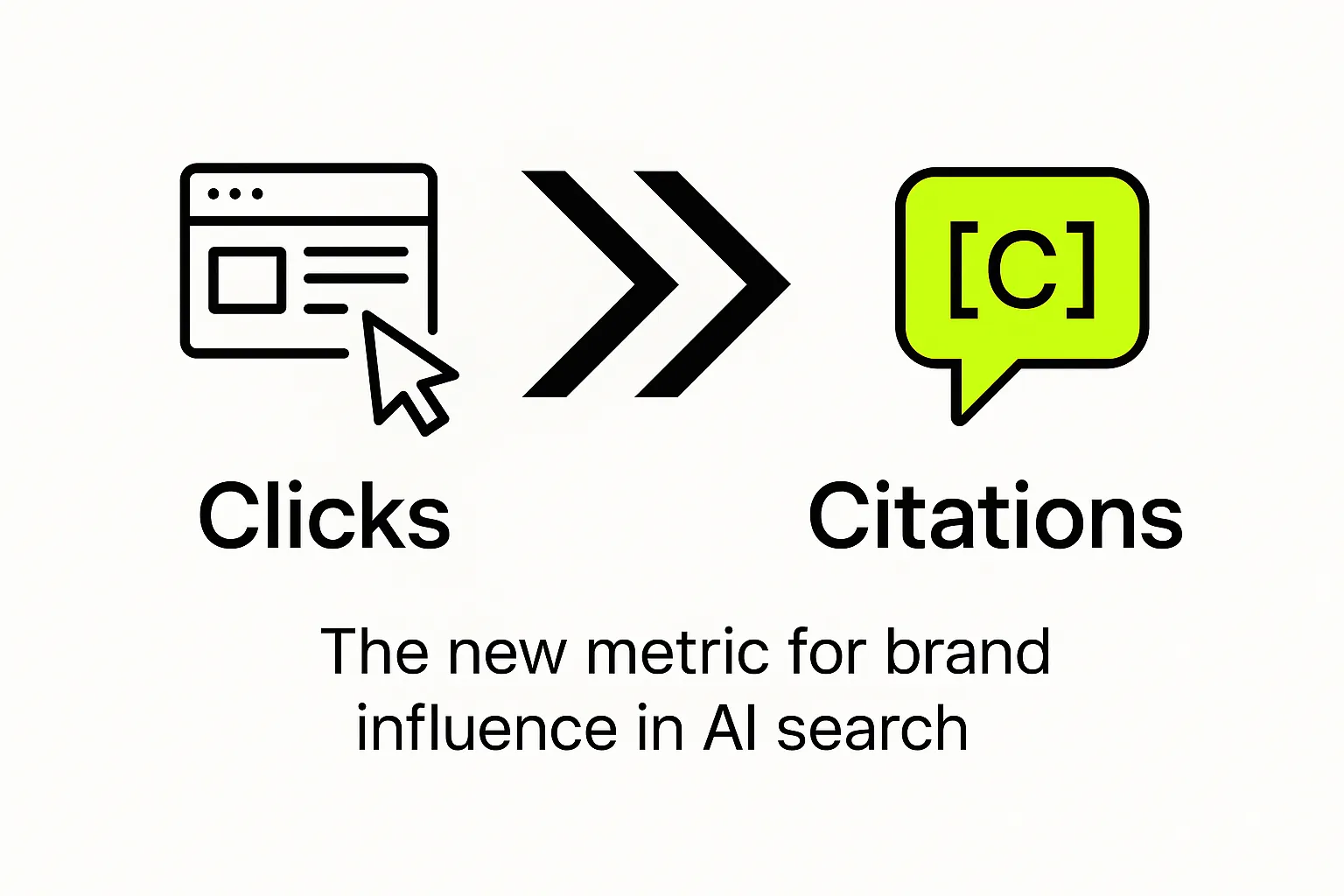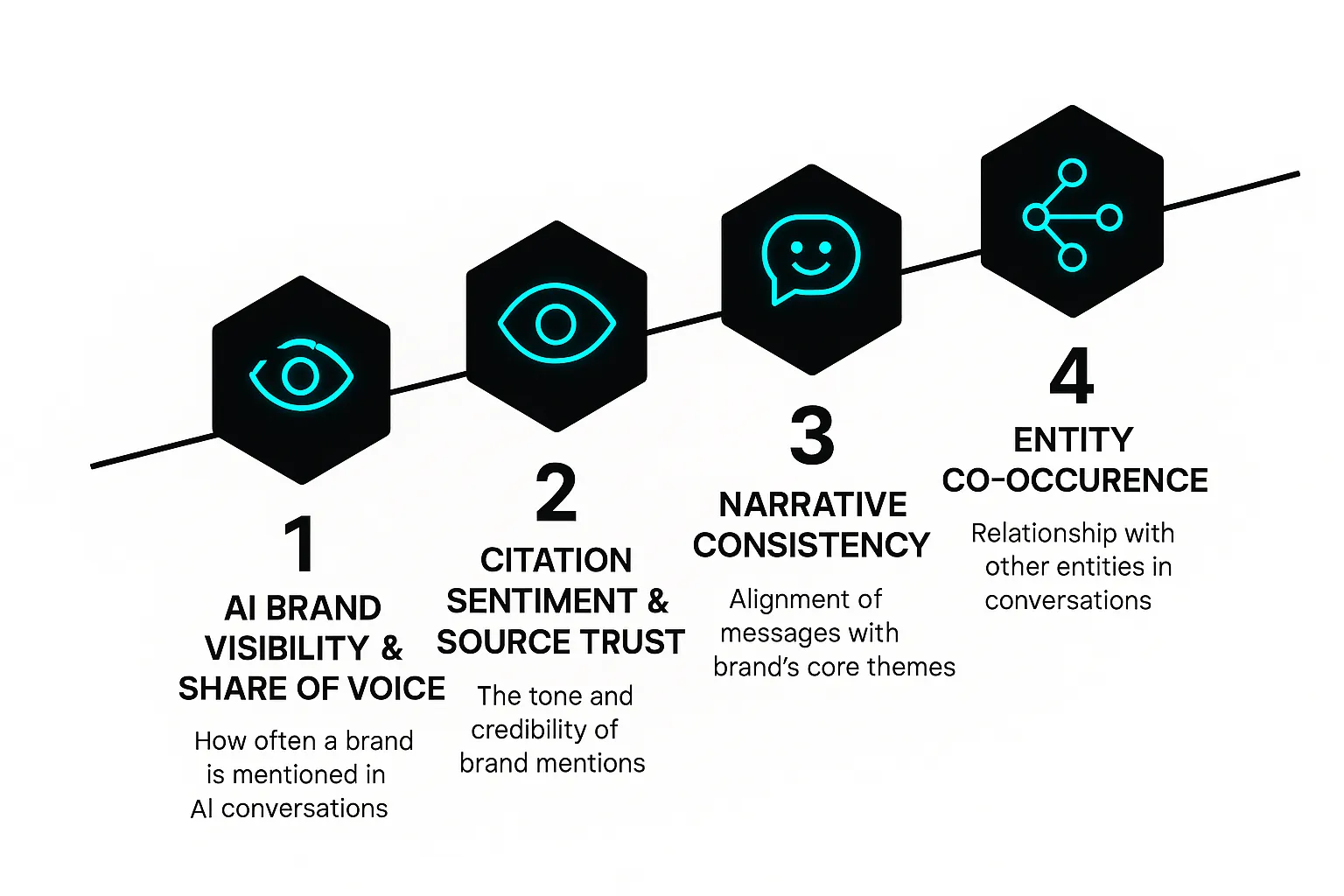Beyond Clicks: Measuring Brand Influence in the Age of AI Search
AI Summary
Beyond Clicks: Measuring Brand Influence in the Age of AI Search explores how conversational AI transforms brand measurement. This article explains the shift from click-based metrics to AI-driven citations and how brands can track influence with new tools.
- Who: Marketers, brand managers, and SEO professionals interested in AI impact on branding.
- What: The evolving methods for measuring brand resonance and influence in AI conversational and generative search.
- When: Now, as AI becomes a primary interface for search and information discovery.
- Where: In digital marketing, search optimization, and AI-powered search engines.
- Why: To adapt brand strategies, improve AI citations, and maintain authoritative presence in the changing search landscape.
Imagine a potential customer asks a question about your industry to an AI assistant. In seconds, it synthesizes information from across the web and provides a confident, conversational answer. Does it mention your brand as a trusted resource? Does it reflect your company’s core message accurately? Or does it cite your competitor, or worse, misrepresent what you do entirely?
This isn't a future scenario. It's happening right now. For decades, we measured online success in clicks, traffic, and rankings. Today, the game has changed. AI is the new front door to information, and in this world, being cited is the new click. Your brand is being defined in these new conversations, and it's time to learn how to measure, and ultimately shape, that narrative.
The Big Shift: From Clicks to Citations
For years, Search Engine Optimization (SEO) was a straightforward exchange. You created great content, optimized it for keywords, and earned a high ranking. The goal was to win a click, bringing a user to your digital doorstep.
Generative search, powered by conversational AI, operates differently. It sifts through countless sources to deliver a single, synthesized answer. It doesn't just want to link to a source; it wants to find the most trustworthy, authoritative information to use in its response. Success is no longer just about driving traffic. It’s about becoming the trusted source the AI relies on and cites.
This is the core of Brand Resonance in the AI era. It’s a measure of how positively, frequently, and accurately AI models understand and represent your brand when answering user questions. It's not about being on the list; it's about being woven into the answer itself.

This visual clarifies the fundamental shift from clicks being the primary success metric to citations by AI as the new measure of brand resonance and influence in generative search.
The Modern Brand Measurement Toolkit
If clicks are no longer the whole story, how do we measure what truly matters? The good news is that fuzzy concepts like "influence" and "reputation" can now be tracked with a new set of metrics. Think of it as a toolkit for understanding your brand’s health in the world of AI.

This process diagram breaks down the essential measurement toolkit into four clear, actionable metrics, empowering readers to understand and evaluate brand influence step-by-step.
AI Brand Visibility and Share of Voice
These are the foundational metrics. They are similar to their traditional counterparts but with a crucial twist.
- AI Brand Visibility measures how often your brand is mentioned or cited by AI models in response to relevant industry queries. It's a simple percentage. If you ask 100 questions about your niche and your brand appears in 15 answers, your visibility is 15%.
- AI Share of Voice (SOV) takes this a step further by comparing your visibility to your competitors. If your brand appears in 15 answers and your top three competitors appear in 10, 5, and 5 answers respectively, you own a significant share of the AI-driven conversation.
Citation Sentiment and Source Trust
Not all mentions are created equal. Getting cited is good, but how you are cited is what truly builds or erodes your brand.
- Citation Sentiment Score analyzes the context of your brand mentions. Are you presented as a leader, an option, or a negative example? A positive citation might be, "Company X is widely regarded as a pioneer in this field." A neutral one could be, "Alternatives include Company X and Company Y." Understanding this sentiment is critical.
- Source Trust Differential looks at the authority of the sources the AI uses when it talks about you versus your competitors. If an AI cites your company using information from a highly respected industry journal but cites a competitor using a forum discussion, you have a positive trust differential. This shows the AI perceives your brand as more authoritative.
Narrative Consistency and Entity Co-occurrence
These advanced metrics help you see the bigger picture of how AI perceives your brand's identity and position in the market.
- Narrative Consistency Index measures how well the AI's portrayal of your brand aligns with your own core messaging. If you define yourself as an innovator but AI answers consistently describe you as a "budget-friendly option," you have a narrative consistency problem.
- Entity Co-occurrence Map reveals what other brands, concepts, or people AI associates with you. Are you mentioned alongside industry leaders and positive concepts like "innovation" and "reliability"? Or are you associated with competitors you don't respect and terms like "outdated" or "complex"?
From Measurement to Mastery: Influencing Your AI Reputation
Understanding these metrics is the first step. The next is influencing them. This is the goal of a new discipline experts are calling Generative Engine Optimization (GEO). Unlike traditional SEO, which focuses on keywords and backlinks, GEO is about building deep, verifiable authority.
It involves three core pillars:
- Cultivating Topical Authority: Consistently creating expert-led, comprehensive content that covers your subject area from every angle.
- Implementing Structured Data: Using schema markup to label your content clearly, so AI models can easily understand who you are, what you do, and why you are an expert.
- Building a Trustworthy Digital Footprint: Earning mentions and citations from other authoritative, trusted sources across the web, from academic papers to respected news outlets.
The objective is to make your brand the most logical, reliable, and authoritative source of information in your field. When you achieve that, AI models will naturally turn to you to help them form their answers.
Your AI Brand Resonance Audit
Starting this journey can feel overwhelming, but you can begin with a simple audit. Take 15 to 20 key questions your customers ask and pose them to different AI platforms.
As you review the answers, ask yourself:
- Is my brand mentioned? How often compared to my competitors? (Visibility & SOV)
- When mentioned, is the context positive and authoritative? (Sentiment & Trust)
- Does the AI's description of my brand match our own messaging? (Narrative Consistency)
This simple exercise will give you a baseline understanding of your brand’s resonance. It will reveal your strengths and, more importantly, highlight the opportunities to start shaping your narrative in the new age of AI. Keeping track of these new marketing metrics in the AI era is the first step toward building a resilient and influential brand for the future.

This memory aid anchors the concept of a unified Brand Resonance Score, visually tying together key metrics to help readers retain how brand influence is assessed holistically.
Frequently Asked Questions
What is generative search?
Generative search refers to a new type of search engine experience where an AI model provides a direct, conversational answer to a user's query instead of just a list of links. It synthesizes information from multiple web pages to create a comprehensive summary or response.
How is AI changing SEO?
AI is shifting the focus of SEO from winning clicks to earning citations. While technical fundamentals still matter, the new priority is establishing topical authority and brand trust. The goal is for AI to see your content as a reliable source to use in its own generated answers. This emerging field is often called Generative Engine Optimization (GEO).
How do I get my brand mentioned in AI search results?
Getting mentioned requires building a strong foundation of expertise, authority, and trustworthiness (E-A-T). This involves publishing high-quality, in-depth content, securing mentions on other reputable websites, using structured data (schema) to help AI understand your content, and ensuring your brand information is consistent across the web.
What are the challenges in measuring brand in conversational AI?
The main challenges are the lack of standardized tools, the dynamic nature of AI models which can give different answers over time, and the difficulty in tracking mentions across numerous AI platforms. Furthermore, it can be hard to reverse engineer why an AI chose one source over another, making optimization a complex process.


